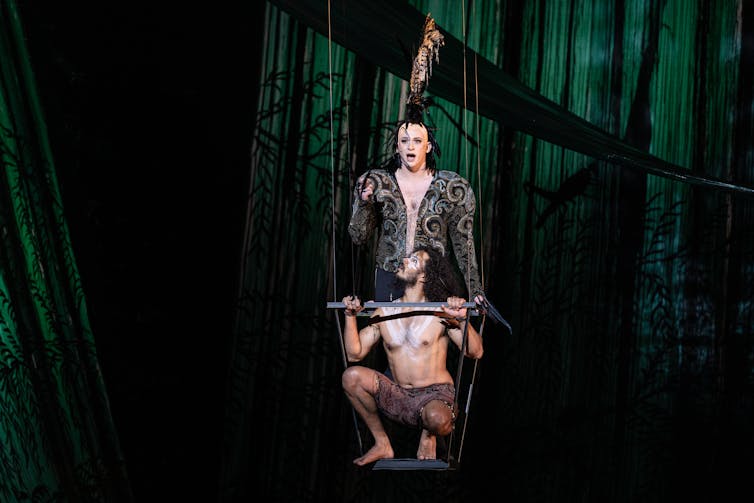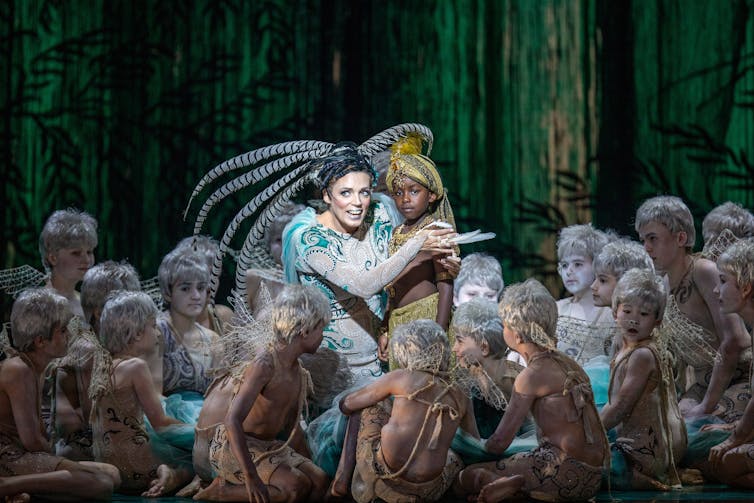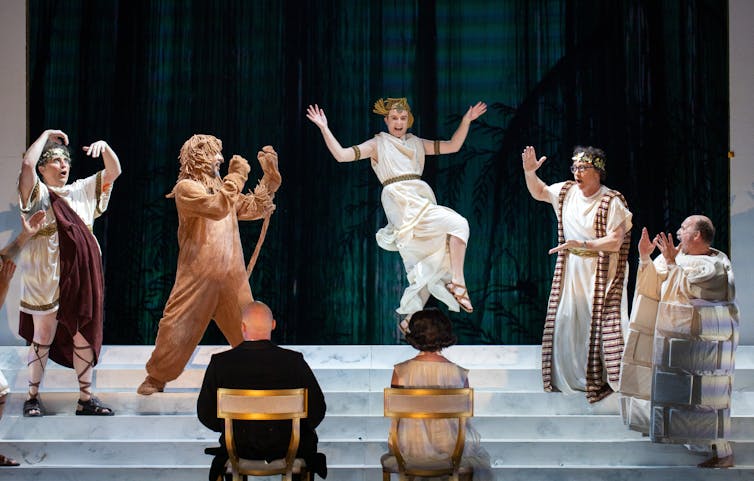Source: The Conversation (Au and NZ) – By William Peterson, Associate Professor, Flinders University
Review: A Midsummer Night’s Dream, by Benjamin Britten, directed by Neil Armfield, Adelaide Festival.
Transfixed, Transported. Transfigured. Three hours pass in the blink of an eye.
How did this happen, or was it all just a dream? For a start, there’s the play, Shakespeare’s A Midsummer Night’s Dream. For many, it is the Shakespeare play we encountered first.
On playing the king of the fairies at age 16, director Neil Armfield recalls:
I cut a rather dashing Oberon – swathed in brown chiffon with knee high lace-up boots and butterfly wing eye make-up.
His words hint at why some of us cringe at this play. We have seen so many dreadful amateur productions that we have forgotten the power and the magic of this work.

The story is both simple and complex. Set in a mythical Athens, one couple (Lysander and Hermia) runs away to elope; another (Demetrius and Helena) is hot on their heels in the forest.
Meanwhile, the power couple ruling the fairy world (Oberon and Tytania) are having marital problems. Enter the sprite Puck, whose misunderstandings of his master Oberon’s instructions cause endless complications until order is restored.
Benjamin Britten’s Midsummer Night’s Dream is not merely a play, but an opera. When it premiered in 1960, Britten was already an accomplished composer and librettist.
And what Britten does departs radically from grand opera of the 19th century. Unlike the great classic Italian operas, there are no “hit” tunes. (Think Nessum Dorma from Puccini’s Turandot. You know this song even if you think you don’t.)
There are no stand and deliver moments in Britten’s opera where an emotive tune is belted out by a static singer. Instead, Britten’s music is inextricably linked to the mood, character, and dramatic action.
Britten excels in marshalling the sounds of a vast orchestra to support action. He conjures the fairy world with the light touch of harps, lively percussion, and stringed instruments sliding between notes, known as glissando .
And Britten likes brass. The unique capacity of the trombone to bellow and slide underscored the play’s comic moments. Muted trumpets, similarly, are particularly good for farting sounds when onstage ridiculousness is at a fever pitch. Who knew?
Superb vocal pairings
Yet despite these musical instructions, Britten’s music is open to a range of interpretive possibilities. And it’s in this space that the creative team led by Armfield and set and costume designer Dale Ferguson weave their extraordinary magic.
Armfield has had lifetime love affair with Britten’s operas, and is the leading interpreter of his work internationally. Having previously directed this opera for the Houston Grand Opera, the Canadian Opera Company, and the Lyric Opera of Chicago, the Adelaide Festival production is its Australian premiere.
It’s a big ticket item, with ticket prices to match. But the creative and human forces required to stage this production are nothing short of gargantuan. Joining a large cast of opera performers of international stature was a sizeable contingent of musicians from the Adelaide Symphony Orchestra, and the Young Adelaide Voices choir.

One of the unique features of this opera is its vocal pairings. The most famous is that of the fairy king and queen, Oberon and Tytania.
Playing Oberon is American opera superstar Aryeh Nussbaum Cohen, who arrived from New York in early January to undergo quarantine. Cohen is one of the few opera singers globally who sings in the vocal range pitched above a tenor, known as a countertenor.
His richly supported voice is beautifully paired with Rachelle Durkin’s Tytania. Durkin’s role relies on the otherworldly vocal embellishments of a coloratura soprano. Together the couple sounds enchanted, not of this world.
The “young” lovers Lysander (Andrew Goodwin) and Hermia (Sally-Anne Russell) and Demetrius (James Clayton) and Helena (Leanne Kenneally) are equally well cast. Their superb musical timing and strong, clear characterisations are a source of delight.
The royal couple, Theseus (Teddy Tahu Rhodes) and Hippolita (Fiona Campbell), who kick off Shakespeare’s play, don’t appear until the final scene. Along with the two couples, they assemble to watch the Mechanicals stage the “tragic comedy” Pyramus and Thisbe. This famous scene has rarely been more hilarious than in the delightful, comic hands of Warwick Fyfe (Bottom) and Louis Hurley (Flute).

Ferguson’s costumes are sensational, particularly the spangly, sequined, form-fitting creations worn by Oberon and Tytania. His superbly magical set is dominated by a translucent, shimmering, floating sheet above the stage.
It’s as if the sky breathes in sync with the orchestra and the audience. As Armfield observes:
Britten’s extraordinary music floats and shimmers, drifts and breathes with the hypnotic pulse of the human body. We are, in a sense, inside the mind, inside a kind of released imagination where the translucent skin of reality lifts and falls with the slow rhythms of enchanted sleep.“
This is a superbly well crafted production. The sure-footed direction, the subtle vocal shadings, brilliant comic timing, orchestral precision, and magical presence of Young Adelaide Voices transported the audience into a world of dream and wonder.
In reviewing the opera’s premiere in 1960, famed music critic Howard Taubman predicted, “The chances are that Mr. Britten’s ‘Dream’ will reach many stages of the world.”
Fortunately for us, his prediction has proven true.
– ref. Enchanted voices: A Midsummer Night’s Dream transports audiences to a place of wonder – https://theconversation.com/enchanted-voices-a-midsummer-nights-dream-transports-audiences-to-a-place-of-wonder-156298







